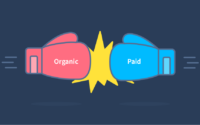What Is Paid Search (Beginner’s Guide)
Paid search can grow any businesses exponentially. If you a beginner for this field, this guide for you. In this tutorial we are going to discuss about what is paid search and the way to use it.
What is paid search?
Paid search is a digital marketing form. If you are a advertiser you can show your ads on search engine results pages (SERPs). Google and Bing are famous search engines. This works on a pay-per-click model. Which means you only have to pay, if someone clicks on your ad. Paid search is a measurable and controllable marketing channel when consider with other traditional forms of advertising.
There are few Ad formats. Text ads are shown at the top or bottom in the organic search results. Shopping ads are shown above the search results. If your website appears in organic search results, you don’t have to pay for a click to your website. You cannot pay to appear in the listings also.
What can paid search do for you?
Every time people search something in search engine. It may be a product, service or solution for their problem. This gives a chance to your business for promote it with relevant audience that search something related to your business. If you use banner ads also called interruption marketing, the people who are seeing it may not wanna purchase your product or service. But in the paid search marketing, the ad will be seen by people whose intent related with your business.
track return on investment
Many new advertisers forget to return on investment. One of important thing in online marketing is you can get measurements easily. For example if you wanna know how many people have clicked on your ads, how much it has cost you, and how many people then take action, you can get measurements easily. The things you should track are given below.
- Contact form submissions
- Online sales
- Live chat engagements
- Phone calls.
Every websites have conversion tracking set up in Google Analytics. Using it you can get an idea about which of your marketing activities gives you best returns.
PPC terminology
There are some terms used in paid search platforms. Some of common terms are given below.
- Click: when someone clicks on one of your ads
- Impression: when your ads are appeared. But it does not mean that users have seen your ads. If your ad in appeared at the bottom of the search results list and if user have not scroll down to the bottom , it will count as impression.
- Click-through rate (CTR): CTR is the percentage of impressions of your ads that result in clicks . If the CTR is higher, its better.
- Average cost-per-click (CPC): Which means how much on average a click has cost
- Average position: Average position is the place that your ads have shown on the results page.
- Cost/conversion: Conversion is the amount you have spent on paid search, divided by the number of conversions that generated. If the conversion is lower, it gives the better results.
- Conversion rate: Conversion rate is the percentage of users who completed a conversion after clicking on your ad. If the conversion rate is higher , it gives the better results.
How does paid search work?
Many paid search platforms work in the same order. The steps you need to follow will be the same.
Step 1. Choose your location settings
You can choose specific countries, cities and zip codes to show your ads.
Step 2. Select your keywords
Keywords are terms that people type in search bar to search something. For example “tv repair shop near me” or “best sushi restaurant” are keywords. You need to find a best keywords that matches with your business. There are many free tools you can get help from. The Google Keyword Planner is one of them. You can find what words people are using throughout the world to find business like yours using it. Bing search engine has it’s own tool also. You can know many details like a range of potential keywords, how many people per month are searching for these keywords, how much competition for those keywords, and how much they’re likely to cost-per-click.
Step 3. Choose the correct match types
There are 4 types of match types in paid search.
- Exact match: If you use exact match keywords, your ads will only be shown when people searches for that exact term. The exact keywords are represented in [womens shoes] order. It picks up plurals and spelling mistakes. Therefore [womens shoes] would also show ads for [women shoes].
- Phrase match: Your ad will be appear when someone search exact phrase but with words before and after that phrase. Phrase keywords are represented like “women’s shoes”.
- Broad match: These kind keywords are represented like women shoes. If someone search this keywords in its order or if someone search it with some synonymous, your ad will appear. For example if you use keyword women’s shoes, your ad will be appeared for keywords like cheap women’s shoes’, ‘women’s blue shoes’ or ‘ladies shoes’.
- Modified broad: These keywords are represented in +women’s +shoes order. Your ad will be shown for this phrase in any order, without synonym. For example, ‘women’s training shoes’ or ‘shoes for women running’.

There is another match type called negative keywords. You can stop your ads from running on searches that are not relevant to your service or product by using negative keywords.
The default match type is broad match. Therefore many advertisers use online broad keywords. As a result their ad would be shown only for the advertisers specific keywords. If there were thousands or millions related searches, the ad won’t appear. Because they have chosen broad match type. You need to select a best match type and make a negative keywords list also. Then you can begin your campaign.
Step 4. Create your ads
Text ads have 3 primary elements and they are like this.
- Headline 1, 30 characters
- Headline 2, 30 characters
- Description, 80 characters.
There are few things you cannot add to your text. They are,
- All caps (e.g. FREE DELIVERY)
- Symbols to draw attention to your ads (e.g. ***Free Delivery***)
- Additional spacing (e.g. F r e e D e l i your ads (e.g. ***Free Delivery***)
- your ads (e.g. ***Free Delivery***)Trademarked terms
- Exclamation marks in the headlines.
What makes a good ad?
Ads needs to grab audience. You need to guide them to select your ad over others. If you wanna make a good ad, make sure to include following things.
- Words and phrases that are relevant to your keywords
- Unique selling points
- Calls to action.
Step 5. Set your bids
Set your bids means set how much you are going to pay for one click on your ad. You don’t have to make the same bid for all your keywords. It called bid or Max. CPC. You can make different bids for different keywords. Paid search platforms like Google give you a guide on how much you should bid on click. But you can bid lower amount than Google recommend. It only caused to show your ads in a lower position or less frequently.
How do search engines decide where your ad appears?
When someone search for your keywords, your ads will be added to an auction to decide its place to appear in the page. There are two factors measure your ad rank. They are bid and quality score of your ad. If you get a higher rank, your ad will be appeared in the first result.
Quality score is a score counted from 1 to 10. If your ad have got 10, which means your ad has a good quality. There are 3 factors used for calculate ad rank. They are expected click-through rate, landing page experience and ad relevance to your keywords.
Step 6. Add ad extensions
You can show additional pieces of information about your business with your ads. This is called ad extensions. Adding ad extensions gives better user experience. It also helps to improve quality score of your ad. It will lead your ad to get more space in search results page. Some of the ad extensions are given below.
- Sitelinks – links to additional pages on your website
- Callouts – additional text about your business
- Location– show your business address
- Call – show your phone number. This gives users on a mobile the option to click-to-call
- Price – show different services or products with the costs
- Seller ratings – these are automated snippets and they will show if your business has reviews on sites like Google My Business or TrustPilot. Seller ratings does not work with all review platforms. Therefore before use them you need to check first.
Step 7. Launch your ads
Now it’s time to launch your ad. It will take a few hours your ads to start showing. You can see the results from your paid search accounts. If you wanna you can pause your at any time.
How do I pay for paid search?
Creating ad campaign is almost same in all the platforms. But when it billing, its different from other platforms. When you create your account, you need to enter your credit card or debit card details. There are two ways to make you charge. You will be charged if a certain threshold has been met or in every 30 days. You will be charged according to the one which comes first.
What are your goals?
Before you start your paid search campaigns, you need to think about what you want to achieve. If not you campaign will lead to failure. When finding a goal, you need to ask two questions from yourself.
- How many new customers do you want?
- How much are you willing to pay for them?
You might think you need to get as many as possible customers. But it’s important to make specific goals. If not you will waste your time and it is hard to customize your audience.
calculating the conversion rate required
After you set your goals, you can check whether they are achievable by calculating the conversion rate. You can calculate it by divide your target cost per conversion by your expected CPC. Many campaigns fail because of not doing this calculation.
After you’ve done your keyword research, then calculate the average CPC. Next look at your desired cost per conversion. Now you can calculate the conversion rate that required. Conversion rate for websites are given below.
- Low risk: 0–2%
- Medium risk: 2–8%
- High risk: 8+%.
If you a beginner of this field, we hope this will be a best guide for you and you will be able to get better results using online marketing strategy.
Related:


